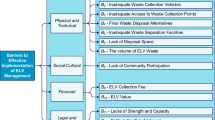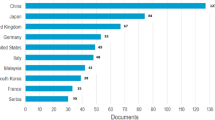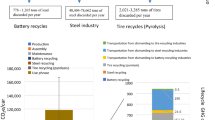Abstract
In a context of transition towards a more circular economy (CE), this study undertakes an analysis of the appropriate transfers and applications of best managerial practices, regulations, and know-how from the automotive sector to the heavy vehicle one, as well as from the European Union (EU) to the United States of America (U.S.), and vice versa. While the EU appears to be a few steps ahead of policy activity regarding the management of end-of-life automotive vehicles (Directive 2000/53/EC and Extended Producer Responsibility principles), the U.S. heavy vehicle industry presents several aspirational industrial practices, including the collaboration between end-of-life actors, supporting parts remanufacturing and facilitating reuse. New empirical findings and lessons learned from both geographical regions are combined with the previous analyses to develop a benchmarking template of commendable CE practices. Against this background, the findings open on the remaining challenges and circular economy opportunities for both regions, as well as for emerging and newly industrialized countries, whose automotive markets are growing fast.
Similar content being viewed by others
References
Arora N, Bakshi SK, Bhattacharjya S (2019) Framework for sustainable management of end-of-life vehicles management in India. J Mater Cycles Waste Manag 21:79–97
Rosa P, Terzi S (2018) Improving end of life vehicle’s management practices: an economic assessment through system dynamics. J Clean Prod 184:520–536
Matthews JA, Tan H, Hu M (2018) Moving to circular economy in China: transforming industrial parks into eco-industrial parks. Calif Manag Rev 60:157–181
Bocken NM, Olivetti EA, Cullen JM, Potting J, Lifset R (2017) Taking the circularity to the next level: a special issue on the circular economy. J Ind Ecol 21:476–482
Geisendorf S, Pietrulla F (2017) The circular economy and circular economic concepts—a literature analysis and redefinition. Thunderbird Int Bus Rev 2017:1–12
Kirchherr J, Reike D, Hekkert M (2017) Conceptualizing the circular economy: an analysis of 114 definitions. Resour Conserv Recycl 127:221–232
Esposito M, Terence T, Soufani K (2018) Introducing a circular economy: new thinking with new managerial and policy implications. Calif Manag Rev 60:5–19
McDowall W, Geng Y, Huang B, Barteková E, Bleischwitz R, Türkeli S, Doménech T (2017) Circular economy policies in China and Europe. J Ind Ecol 21:651–661
Liu L, Liang Y, Song Q et al (2017) A review of waste prevention through 3R under the concept of circular economy in China. J Mater Cycles Waste Manag 19:1314
Slavík J, Remr J, Vejchodská E (2018) Relevance of selected measures in transition to a circular economy: the case of the Czech Republic. Detritus 1:144–155
Buruzs A, Tomas A (2017) A Review on the outlook of the circular economy in the automotive industry. Int J Environ Ecol Eng 11:6
Saidani M, Yannou B, Leroy Y, Cluzel F (2018) Heavy vehicles on the road towards the circular economy: Analysis and comparison with the automotive industry. Resour Conserv Recycl 135:108–122
Wilson M (2017) Key to the concept—Automotive manufacturers must embrace parts reuse because it is key to the industry’s circular economy. Recycling Today, August 31, 2017. http://www.recyclingtoday.com/article/automotive-parts-reuse. Accessed 15 Jan 2019
Saidani M, Kendall A, Yannou B, Leroy Y, Cluzel F (2018) What about the circular economy of vehicles in the U.S.? An extension of the analysis done in the EU by Saidani et al. (2017). Conserv Recycl 136:287–288
Sakai S, Yoshida H, Hiratsuka J et al (2014) An international comparative study of end-of-life vehicle (ELV) recycling systems. J Mater Cycles and Waste Manag 16:1–20
ACEA-European Automotive Manufacturers Association (2017) Statistics-vehicles in use. http://www.acea.be/statistics/tag/category/vehicles-in-use. Accessed 15 Jan 2019
Bento AM, Roth KD, Zuo Y (2013) Vehicle lifetime trends and scrappage behavior in the U.S. used car market. http://dx.doi.org/10.2139/ssrn.2262593. Accessed 15 Jan 2019
USDoT-US Department of Transportation (2017) National Transportation Statistics. https://www.rita.dot.gov/bts/sites/rita.dot.gov.bts/files/publications/national_transportation_statistics/index.html. Accessed 15 Jan 2019
Statista (2017) Motor Vehicle Production. https://www.statista.com/topics/975/motor-vehicle-production. Accessed 15 Jan 2019
Eurostat (2019) End-of-Life Vehicles (ELVs) Key Waste Streams. https://ec.europa.eu/eurostat/web/waste/key-waste-streams/elvs. Accessed 15 Apr 2019
SCADA-State of California Auto Dismantlers Association (2017) The Underground Economy: Report & Recommendations. https://www.dtsc.ca.gov/GetInvolved/ReviewPanel/upload/SCADA-DTSC-IRP-Ltr-1-16-dskv1.pdf. Accessed 15 Jan 2019
Statista (2017) US Light Vehicle Average Curb Weight. https://www.statista.com/statistics/660493/us-light-duty-vehicle-average-curb-weight. Accessed 15 Jan 2019
Ellen MacArthur Foundation (2013) Towards the Circular Economy—Economic and Business Rationale for an Accelerated Transition, Cowes, UK
Directive 2000/53/EC of the European Parliament and of the Council of 18 September 2000 on end-of life vehicles. Official Journal of the European Communities, 21 October 2000
Directive 2005/64/EC of the European Parliament and of the Council of 26 October 2005 on the type-approval of motor vehicles with regard to their reusability, recyclability and recoverability. https://eur-lex.europa.eu/LexUriServ/LexUriServ.do?uri=OJ:L:2005:310:0010:0027:EN:PDF. Accessed 15 Jan 2019
Kunz N, Mayers K, Van Wassenhove LN (2018) Stakeholder views on extended producer responsibility and the circular economy. Calif Manag Rev 60:45–70
Directive 2008/98/EC of the European Parliament and of the Council of 19 November 2008 on waste and repealing certain directives. https://eur-lex.europa.eu/legal-content/EN/TXT/?uri=celex%3A32008L0098. Accessed 15 Jan 2019
Directive 2010/75/EU of the European Parliament and of the Council of 24 November 2010 on industrial emissions (integrated pollution prevention and control). https://eur-lex.europa.eu/legal-content/EN/TXT/?uri=celex%3A32010L0075. Accessed 15 Jan 2019
Konz R (2009) The end-of-life vehicle (ELV) directive: the road to responsible disposal. Minn J Int’l L 18:43
European Commission (2015) Closing the loop—An EU action plan for the Circular Economy. The Circular Economy Package Proposal. Communication from the Commission to the European Parliament, the Council, the European Economic and Social Committee and the Committee of the Regions. Brussels, Belgium
Accenture (2016) Automotive’s Latest Model: Redefining Competitiveness through the Circular Economy. https://www.accenture.com/us-en/insight-redefining-competitiveness-through-circular-economy. Accessed 15 Jan 2019
Delmas MA, Cuerel Burbano V (2011) The drivers of greenwashing. Calif Manag Rev 54:64–87
DoT CA (2017) What are the rules and regulations for truckers in California? http://www.dot.ca.gov/hq/paffairs/faq/faq32.htm. Accessed 15 Jan 2019
USITC (2013) The USITC Remanufacturing Report: Key Findings, Observations, and Insights. The 2013 Remanufacturing Industry Roundtable, April 11, 2013
ADEME (2016) Chiffres clefs et évolution des taux de réutilisation, recyclage/valorisation des VHU. JUIN –DD’16, Montreuil, France, October 2016
Oeko-Institute (2017) Assessment of the implementation of Directive 2000/53/EU on end-of-life vehicles (the ELV Directive) with emphasis on the end of life vehicles of unknown whereabouts. Report, Chapter 3.2, December 2017
Palmeira VN, Guarda GF, Kitajima LFW (2018) Illegal international trade of e-waste—Europe. Detritus 1:48–56
Article 6 of EU Regulation No. 566/2011
Regulation (EC) No 715/2007 of the European Parliament and of the Council of 20 June 2007 on type approval of motor vehicles with respect to emissions from light passenger and commercial vehicles (Euro 5 and Euro 6) and on access to vehicle repair and maintenance information
International Dismantling Information System (2019). http://www.idis2.com/index.php?action=home&language=english. Accessed 15 Apr 2019
INDRA Automobile Recycling, 2019. http://www.indra.fr/en/recycling_engineering.html. Accessed 15 Apr 2019
HDDA (2017) Product Standards for Heavy-Duty Aftermarket in Development. http://autocare.org/Who-We-Are/Segments/HDDA/HDDA--Heavy-Duty.html. Accessed 15 Jan 2019
Gaudillat PF, Antonopoulos IS, Dri M, Traverso M, Canfora P (2017) Best Environmental Management Practice for the Car Manufacturing Sector, JRC Science for Policy Report
USUBC (2015) Top 50 manufacturers of construction machinery. http://www.usubc.org/files/Zeppelin_top_50_manufacturer_%20construction%20machinery.pdf. Accessed 15 Jan 2019
Statista (2018) Worldwide leading truck manufacturers based on production figures. https://www.statista.com/statistics/270293/worldwide-leading-truck-manufacturers-based-on-production-figures. Accessed 15 Jan 2019
Wikipedia (2018) List of manufacturers by motor vehicle production. https://en.wikipedia.org/wiki/List_of_manufacturers_by_motor_vehicle_production. Accessed 15 Jan 2019
Saidani M (2018) Monitoring and advancing the circular economy transition: circularity indicators and tools applied to the heavy vehicle industry. PhD Thesis, Industrial Engineering. CentraleSupélec, Université Paris-Saclay
Saidani M, Yannou B, Leroy Y, Cluzel F, Kendall A (2019) A taxonomy of circular economy indicators. J Clean Prod 207:542–559
Moriguchi Y (2007) Material flow indicators to measure progress toward a sound material-cycle society. J Mater Cycles Waste Manag 9:112
Lishan X et al (2018) Comparative life cycle assessment of manufactured and remanufactured loading machines in China. Resour Conserv Recycl 131:225–234
Ribeiro JS, Gomes JO (2015) Proposed framework for end-of-life aircraft recycling. Procedia CIRP 26:311–316
MORE AERO (2019) Modularized Aircraft Recycling by Development and Testing of a Mobile Recycling Unit for the Aerospace Sector. https://www.süderelbe.hamburg/en/aircraftrecycling.html. Accessed 15 Apr 2019
Keivanpour S, Kadi DA, Mascle C (2015) End of life aircrafts recovery and green supply chain: a conceptual framework for addressing opportunities and challenges. Manag Res Rev 38:1098–1124
European Remanufacturing Network (2015) Remanufacturing Market Study, for Horizon 2020. Chapter 9: Heavy-Duty and Off-Road equipment, November 2015
US International Trade Commission (2012) Remanufactured Goods: An Overview of the U.S. and Global Industries, Markets, and Trade. Chapter 4: Heavy-Duty and Off-Road (HDOR) Equipment, Investigation No. 332-525, USITC Publication 4356, October 2012
Acute Market Reports (2017) Global Automotive Parts remanufacturing Market Size, Market Share, Application Analysis, Regional Outlook, Growth Trends, Key Players, Competitive Strategies and Forecasts, 2017 to 2025 Report September 2017
Weiland FW (2014) European remanufacturing of heavy-duty and off-road vehicle components (including tyres): a hidden giant? FWJ Consulting
Snodgress D (2012) Sustainable development—Our focus & commitment. Cat Reman, September 2012
Ellen MacArthur Foundation (2015) The Circular Economy Applied to the Automotive Industry. http://www.ellenmacarthurfoundation.org/circular-economy/interactive-diagram/the-circular-economy-applied-to-the-automotive-industry. Accessed 15 Apr 2019
Volvo Group (2015) The Volvo Group Annual and Sustainability Report 2015. Report, pp. 22
Volvo Truck Corporation (2012) Disassembly instructions, complete vehicle. Service Information, Volvo Truck Corporation, Göteborg
Toyota (2016) Vehicle Recycling. https://www.toyota-europe.com/world-of-toyota/feel/environment/better-earth/recyclehttps://global.toyota/en/sustainability/report/vehicle-recycling/. Accessed 15 Apr 2019
Manitou Group (2016) Handling your world. Annual Report 2015. May 2016
Acknowledgements
The authors would like to acknowledge the support of the Fulbright Commission and the Institute of International Education to make possible this study through a research collaboration between the University of California-Davis, in the U.S., and CentraleSupélec, Université Paris-Saclay, in France. The authors also thank all the industrialists who not only took the time to go over or experiment our proposed benchmarking template but also provided insightful comments on it. Last but not least, the authors would like to thank the two reviewers for their insightful comments and valuable suggestions, including complementary information and additional relevant references that have been analyzed and incorporated, to augment the quality and content of this research work.
Author information
Authors and Affiliations
Corresponding author
Additional information
Publisher's Note
Springer Nature remains neutral with regard to jurisdictional claims in published maps and institutional affiliations.
Electronic supplementary material
Below is the link to the electronic supplementary material.
Rights and permissions
About this article
Cite this article
Saidani, M., Kendall, A., Yannou, B. et al. Management of the end-of-life of light and heavy vehicles in the U.S.: comparison with the European union in a circular economy perspective. J Mater Cycles Waste Manag 21, 1449–1461 (2019). https://doi.org/10.1007/s10163-019-00897-3
Received:
Accepted:
Published:
Issue Date:
DOI: https://doi.org/10.1007/s10163-019-00897-3




